Variation: Cakelike Textured Scones
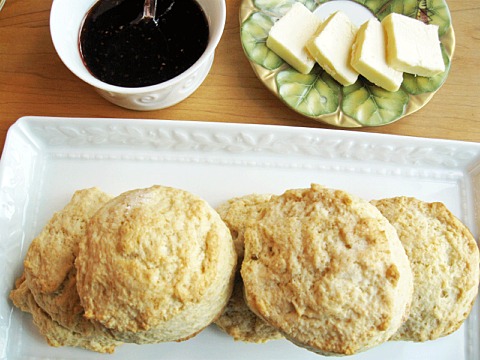
Scones by Sarah Phillips; Photo by Tara Korde © Sarah Phillips
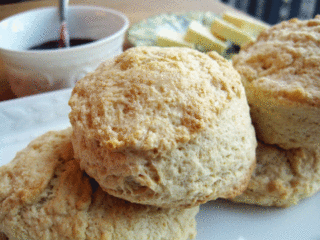
Recipe made without red tart cherries and cut with a round biscuit cutter!
These scones are made flaky by “cutting in” cold butter into the flour and excluding eggs which would make them more cake-like. Today's trend is to dress up scones with dried fruit, citrus zest, chocolate chips, orange or lemon flavoring, ginger, poppy seeds, herbs, cheese, bacon, or vegetables. Adding fresh berries or fruit to a scone recipe doesn't work because this dough is kneaded and kneading squishes the fruit. This means that the dough gets too wet from the juice.
QUICK-BREAD RECIPE HELP
Katherine, Premium Member Says: “I made the Flaky Cherry Scones the other day and they were gone in a flash! It's my favorite recipe now. “
INGREDIENTS
1/2 cup (1 stick) of unsalted butter, cold
2 cups unbleached all-purpose flour; spoon into measuring cup and level to top
1/4 cup sugar
2 teaspoon baking powder
1/2 teaspoon salt
3/4 cup heavy cream or half-and-half, cold; measure in liquid measuring cup
1/2 cup dried tart red cherries, dried cranberries or raisins
2 tablespoons sugar and extra heavy cream for brushing tops
INGREDIENTS
1. Position a rack in the middle of the oven and preheat the oven to 400 degrees F. Line a baking sheet with parchment paper and set aside.
2. Cut the butter into 1/2-inch cubes and refrigerate it for 30 minutes or freeze it for 10 minutes to get really cold.
SARAH SAYS: My butter was frozen, so I grated it on the large holes of a box grater and then refroze it.
3. In a medium bowl, combine the flour, sugar, baking powder, and salt. Sprinkle the chilled butter cubes over the flour and toss with a spoon so the butter is completely covered in flour.
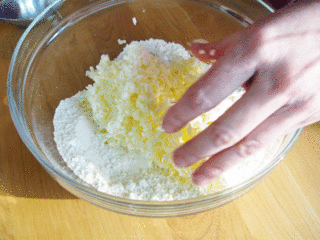
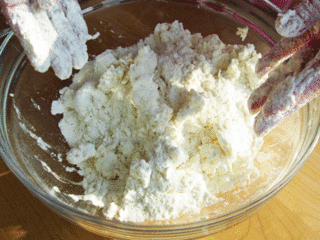
SARAH SAYS: Since I grated the butter, I added the small grated pieces to the flour mixture and tossed them together lightly with my fingertips. D onot use your palms; they are the warmest part of your hands. The goal is to not melt the butter in the scone mixture before they go into a hot oven.
NOTE: If your butter is cut into 1/2-inch cubes, “cut” the butter into the dry ingredients with two knives (in a scissor motion) or a pastry blender until the butter pieces are no larger than small peas. Skip this step is your butter has been grated; the butter pieces are already small in size.
4. Pick up a small clump of butter and flour with your fingertips. Squeeze the butter and flour in between the tip of your thumb and fingertips, and then let the squished clumps fall back into the bowl.
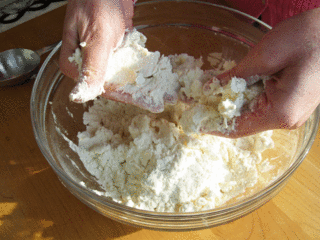
SARAH SAYS: The small cold grated butter pieces could be quickly incorporated into the flour mixture for a truly flaky scone.
Repeat with another clump of flour and butter. Continually toss the flour and butter pieces in the bowl with a large spoon and pick up clumps of flour and butter and press the butter into the flour so it forms large flakes. Make sure you reach down into the bottom of the bowl.
If the butter becomes greasy and soft, place the entire bowl into the freezer and then freeze for about 5 minutes until hardened.
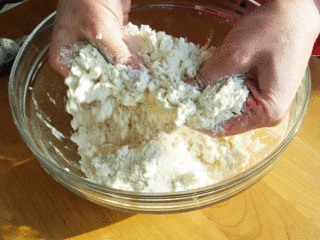
Continue until the flour mixture looks shaggy with large clumps of butter and flour incorporated together, mixed in with smaller clumps.
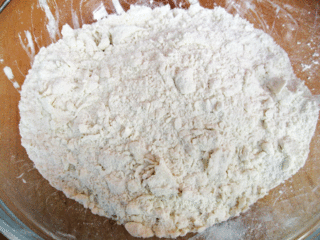
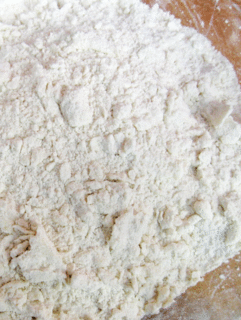
5. Make a well in the center of the smooshed dry/butter ingredients and pour in the cream. With a large spoon, mix in the cream until the dough starts to hold together in large clumps.
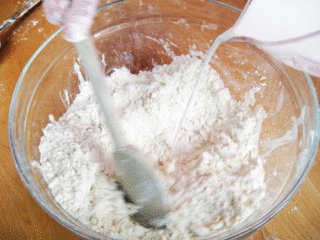
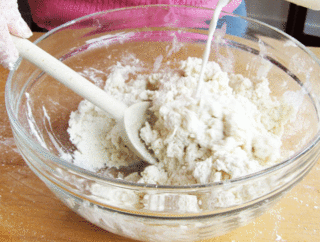
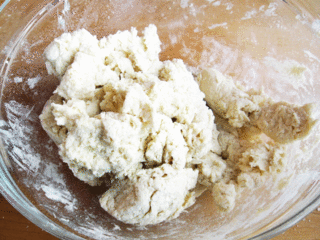
SARAH SAYS: If adding in red tart cherries, add cream and mix until dough is just moistened and looks shaggy and still dry. Add the cherries. Stir a couple of strokes past shaggy, and add a little more cream, if necessary, until the dough starts to come together in large clumps.
6. Place the dough on work surface and knead until the dough just holds together. You need not flour the work surface if the dough has been mixed properly; it should barely come together and should not be overly sticky.
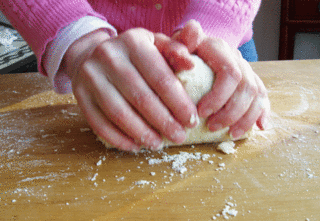
7. Lightly pat the dough into an 8-inch round, about 1/2-inch thick. Cut with a 1- to 1 1/2-inch round biscuit cutter straight down into the dough.
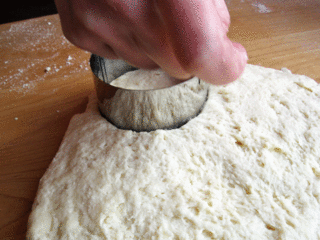
8. Remove the dough from around the cut-out shape.
SARAH SAYS: With the dough scraps, just place them on top of one another, and press together; do NOT knead. Pat the resulting dough mound out on the countertop about 1/2-inch thick and cut-out scone shape with the biscuit cutter.
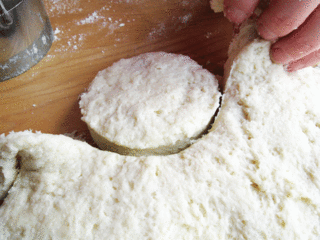
9. With a long thin metal spatula, carefully lift up the scone dough and place it on the prepared baking sheet, about 2-inches apart.
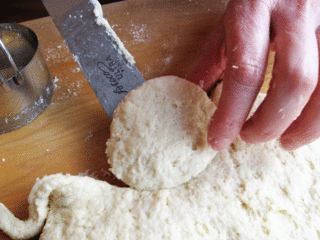
10. Repeat with the remaining dough.
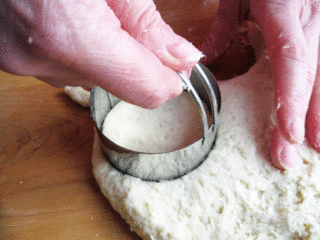
SARAH SAYS: You can also Lightly pat the dough into an 8-inch square, 1/2-inch thick. Cut it into triangles and place on a prepared baking sheet.
11. Brush scone tops lightly with heavy cream; sprinkle with remaining 2 tablespoons sugar.
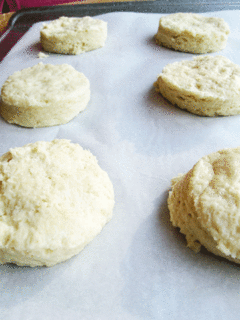
12. Bake for 20 minutes until puffy, the edges and the tops lightly browned and crusty. A scone should sound hollow when tapped on. Take the scones from the oven and cool on a wire cake rack. Serve warm.
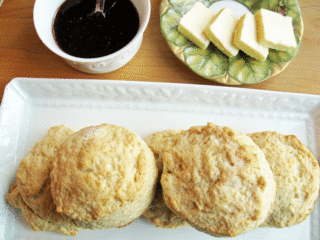
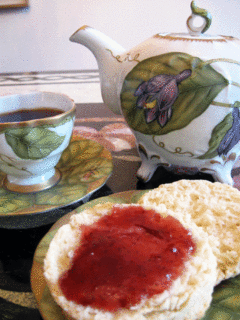
STORAGE
Scones are best served the day they are made, ideally warm from the oven, but can be reheated at 350 degrees F. for a few minutes. If you have extras, let them cool thoroughly and wrap in plastic wrap, place in an airtight plastic bag or container, and freeze. They'll stay good for about a month. To reheat, let them thaw in their wrapping at room temperature, unwrap, and warm in a 350 degrees F. oven for 5 minutes.
VARIATION
Cake-like Textured Scones: use 1 cup heavy cream instead of 3/4 cup and work the dough very lightly.


